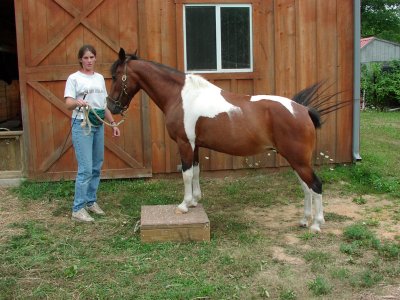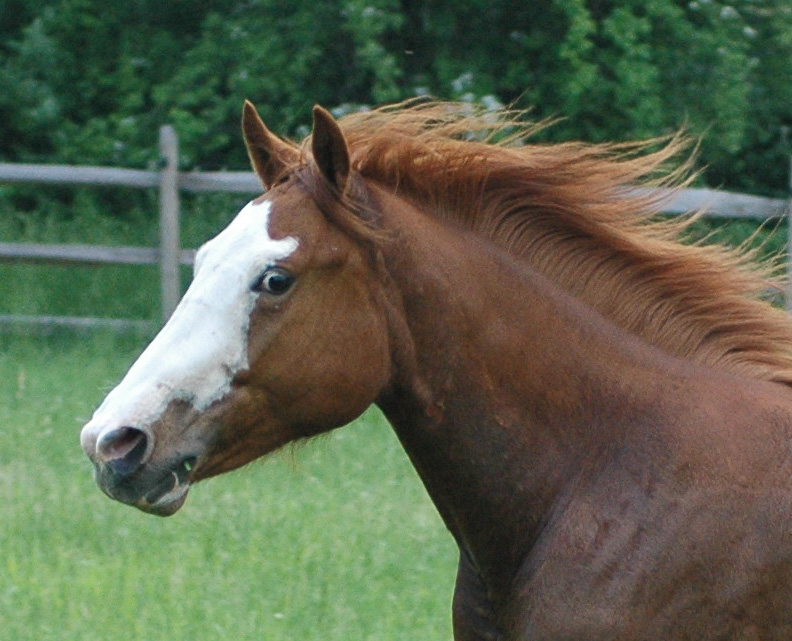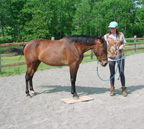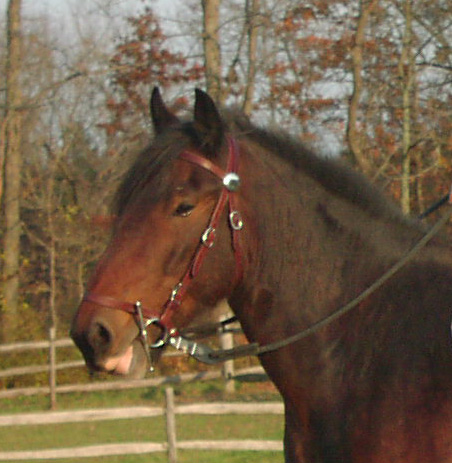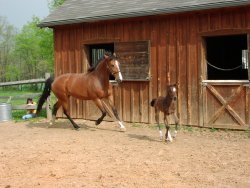|
Getting Started With Riding: Handling and Delivering
Food
Many people use clicker training for husbandry, basic ground manners
and groundwork, but not for riding.
I think there are a few reasons for this, one being that
there is less information out there about how to do it. So I am
going to write a few articles that cover some of the most commonly
asked questions about getting started clicker training under saddle.
Why clicker train from the saddle?
Clicker training while riding offers all the same benefits of
clicker training behaviors from the ground. The marker
provides clarity and the reinforcer provides motivation and makes
the learning process more enjoyable for my horse. I also get
additional benefits including increased focus, desire to work
together, and a better level of communication. When riding, I
think that being able to use a marker signal (the click) is a big
advantage because I can click, allow the horse to stop, reinforce
and maintain the clarity about exactly what behavior was being
reinforced. Especially at faster gaits, there can be a lot of
things going on and the precision of the clicker can make a huge
difference in how well the horse understands what I want.
There are a lot of different ways to transition from groundwork to
riding, depending upon how much you want to teach from the ground
vs. from the saddle. I often start teaching ďriding behaviorsĒ on
the ground with some simple exercises and then do the same exercises
under saddle. In
some cases, I will almost finish a behavior on the ground before
trying it under saddle. It really depends upon where I think it will
be easier for the horse and what information I need to have as I am
shaping. There are some behaviors where I want to know what it feels
like, as opposed to what it looks like, so with those behaviors I
tend to add in some ridden work earlier.
In either case, once the horse is used to being clicker trained
under saddle and I have worked on some simple behaviors, then I can
start to ask for new combinations or develop those behaviors
further. I find that I
can go back and forth between ground and riding exercises, adding
little bits and improving things as needed.
By using clicker training both on the ground and under saddle, it's
easy to be consistent about how I train. This makes it easier
for the horse because riding just becomes an extension of
groundwork. Alexandra Kurland likes to say that "riding is just
groundwork where you get to sit down."
However you choose to do it, the first step is making sure that your
horse understands how to get his reinforcement when you are sitting
on his back.
Here is my list of things I do to prepare a horse for clicker
training under saddle:
1. Decide what
kind of food I want to use as a reinforcer.
While I can reinforce with things other than food, I do
always carry some food.
In some cases, I may be able to use the same food that I use for
clicker training on the ground, but some horses have more trouble
taking food from my hand when I am feeding to the side, so I might
have to experiment with this.
Some things to consider are:
-
The
size of the food. I
find most horses do better if I feed one or two larger items
(carrot pieces or larger pellets).
In some cases, I have had horses that did better with a
handful of grain, but I find this tends to be messier and they
want to pick up pieces they have dropped.
Some people do report that initially their horses did better
with longer pieces of food like carrot slivers until they got
used to taking food from the side.
-
Can the horse eat it while wearing his
tack? Itís a good
idea to check and make sure the horse is comfortable eating
the chosen reinforcer while he is tacked up.
I usually let my horses practice eating treats while
wearing their bridles as preparation for being treated while
being ridden. If the horse has trouble with larger treats, then
I start with grain and change to larger treats once the horse is
comfortable eating grain.
2. Decide where
I am going to keep the food.
Here are some of the most common ways to carry food:
-
In a vest Ė
fishing or hunting vests with lots of pockets are often used by
clicker trainers on the ground and they work just as well under
saddle. Do make sure
the pockets are deep enough that the treats donít fall out when
you bend over.
-
In a treat
pouch/fanny pack/nail apron Ė something you buckle around your
waist. There are a lot of different options for this depending
upon how many pockets you want and how much food you want to
carry.
-
In
your coat pocket Ė this is what I do in the fall/winter when I
am already wearing a coat.
Some coats work better than others. It depends upon the
type of pockets. I find that ďpatch pocketsĒ which open at the
top are the easiest, but they can be harder to find.
-
On the saddle/saddle pad- some people use
saddlebags or some kind of bag they can attach to the saddle. I
made pockets that I can attach to my saddle pad with Velcro and
I use them for treats. Some trail riding saddle pads come with
pockets.
3. Check to make
sure that I am comfortable leaning forward to give the horse his
treat.
-
Even with a very
flexible horse, I am going to have to lean forward to feed him
from the saddle. Itís
important to make sure that I am ok doing this and that I can do it
without making myself unstable in the saddle. Every
horse and tack combination is a little different so I always
check to make sure I am ok leaning forward to feed and that my
horse is ok when I lean forward.
-
If I am feeding on a young horse or in a situation where my
horse might be anxious or jumpy, I am extra careful about how I
feed. I lean forward only as much as necessary and I make sure my
legs are in position to support me if he goes in any direction.
4. Teach my horse how to take food from the
saddle. If I have been
feeding the horse so his head is straight forward, he will have to
learn how to bring his nose around toward his side and my hand to
get his reinforcement. Learning to do this often involves a combination of
understanding itís ok to bring his head around and coordination. Here are the steps I use to prepare a horse for food delivery
from the saddle:
-
Targeting Ė
I will check to see how comfortable my horse is with bringing
his head around by doing some simple targeting exercises.
I start by asking for a little lateral flexion with the
target and build up to asking him to come around toward me when
I am standing by his elbow.
-
Lateral flexions Ė I do the same behavior
but using a rein cue. This gives me a way to ask the horse to
bring his nose around for the treat.
If you ride with a target you could probably skip this
step, but I do like to be able to touch the rein to tell the
horse which side the food will be on.
You can also tap the neck to tell the horse where the
food will be.
-
Stand on the mounting block, click and
treat. If you do
this from both sides, itís a good way to check that your horse
understand he can get treats from both sides and you will tell
which one. I like to do
this as it is more similar to the idea of treating while riding
which has an element of the treat coming down from above.
-
Sit on the horse, click and treat at a
standstill. With a
horse that is new to clicker training under saddle, I check to
make sure heís ok with taking a treat from both sides, before I
walk off.
-
If you have two people, you can make some
of the steps easier by having one person on the ground who does
the treating and then transfer that job to the rider by having
the ground person
move toward the riderís location and then switch who is
treating.
5.
What if my horse has trouble taking the treat?
-
Is he
uncomfortable bringing his head around?
If the horse was fine with the targeting exercises and lateral
flexions, then I might want to check to see what is different when
I am in the saddle. The horse could just be unsure what to
do when I shift my weight or there may be some physical issue
that needs to be resolved. I know someone whose horse
would not take treats and she found out that the saddle was digging
in when the mare turned her head and neck to the side. She changed
saddles and the mare was fine. That's
kind of an extreme example but I have also seen more subtle tack
problems that can show up when feeding from the saddle.
Some horses are stiffer in their necks or have more trouble
balancing in a lateral flexion. With these horses, thatís usually a
sign that they would benefit from more groundwork/suppling exercises
or that they might need to be seen by an equine body worker.
-
What if he
brings his head around but then takes the treat by snatching or
grabbing?
Some horses just arenít very coordinated and have trouble taking a
treat gently from what can seem like an awkward position. In
general, they just need more practice, but I can experiment around
with different treats, different size treats, or spend more time
practicing on the ground.
If I can get a helper, the helper can assist with feeding,
as well as give me feedback on what the horse is doing when I
feed. Sometimes another
set of eyes is useful to watch the horseís balance as I feed and
that can give me some information about things to change.
-
Is he the same on both sides?
Itís also worth
noting if the horse finds it easier taking treats from one side than
the other. When I ride,
I usually treat on the side that is easier, which is usually on the
inside of the bend. If am on a straight line and my horse is
straight, I can feed to either side, or to the side that is usually
easier for both of us. I do think itís a good idea to get in the
habit of treating from both sides. It will make you both more
symmetrical. But if one
side is more difficult you can start by doing the easier side and
then slowly work toward doing both sides.
Once your horse is comfortable taking treats from the saddle, I am ready to start using clicker training to teach and improve
the
horseís ridden work.
As I mentioned in the beginning of this article, there are
different ways to go about doing this, depending upon how much you
like to teach from the ground vs. from the saddle.
But there are a few common questions about what you want the horse
to do when you click, after you feed and how you ride for longer if
you have to keep stopping and feeding all the time. Iíll address
these in another article next week.
If you have questions about using clicker training under
saddle, you can email them to me and Iíll try to include the answers
in the next article.
Happy clicking!
Katie
Questions, comments, thoughts? you can email me at
kabart315@gmail.com
Katherine Bartlett, copyright 2015. If you would like to share this
article, please share the link to the entire article. If you would like to share
or copy part of this article, please email me for permission.
Back to Articles
|


